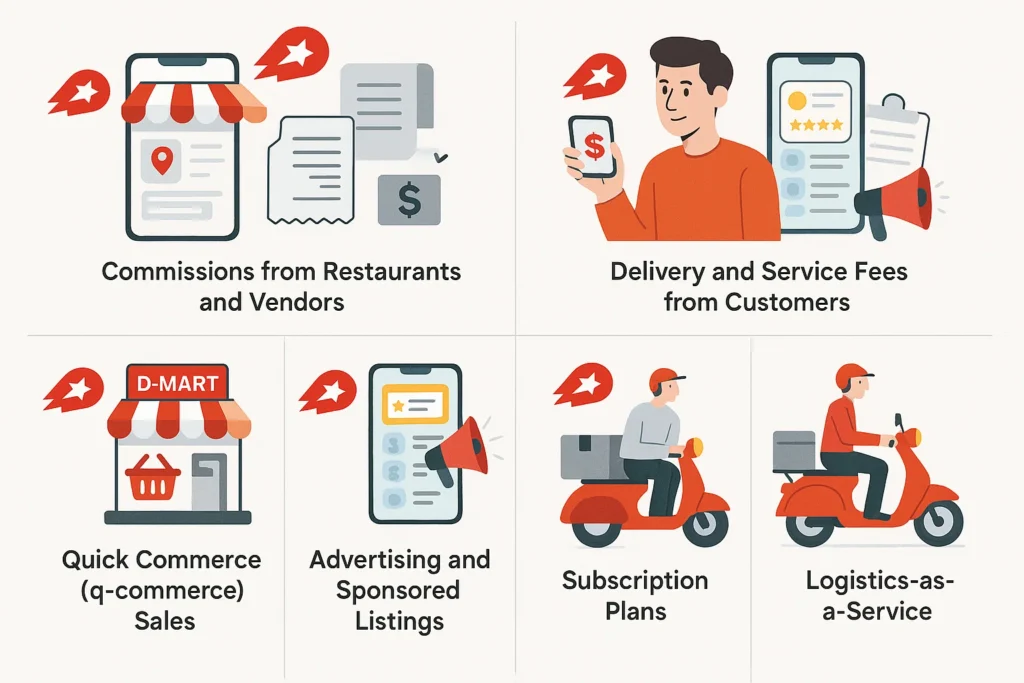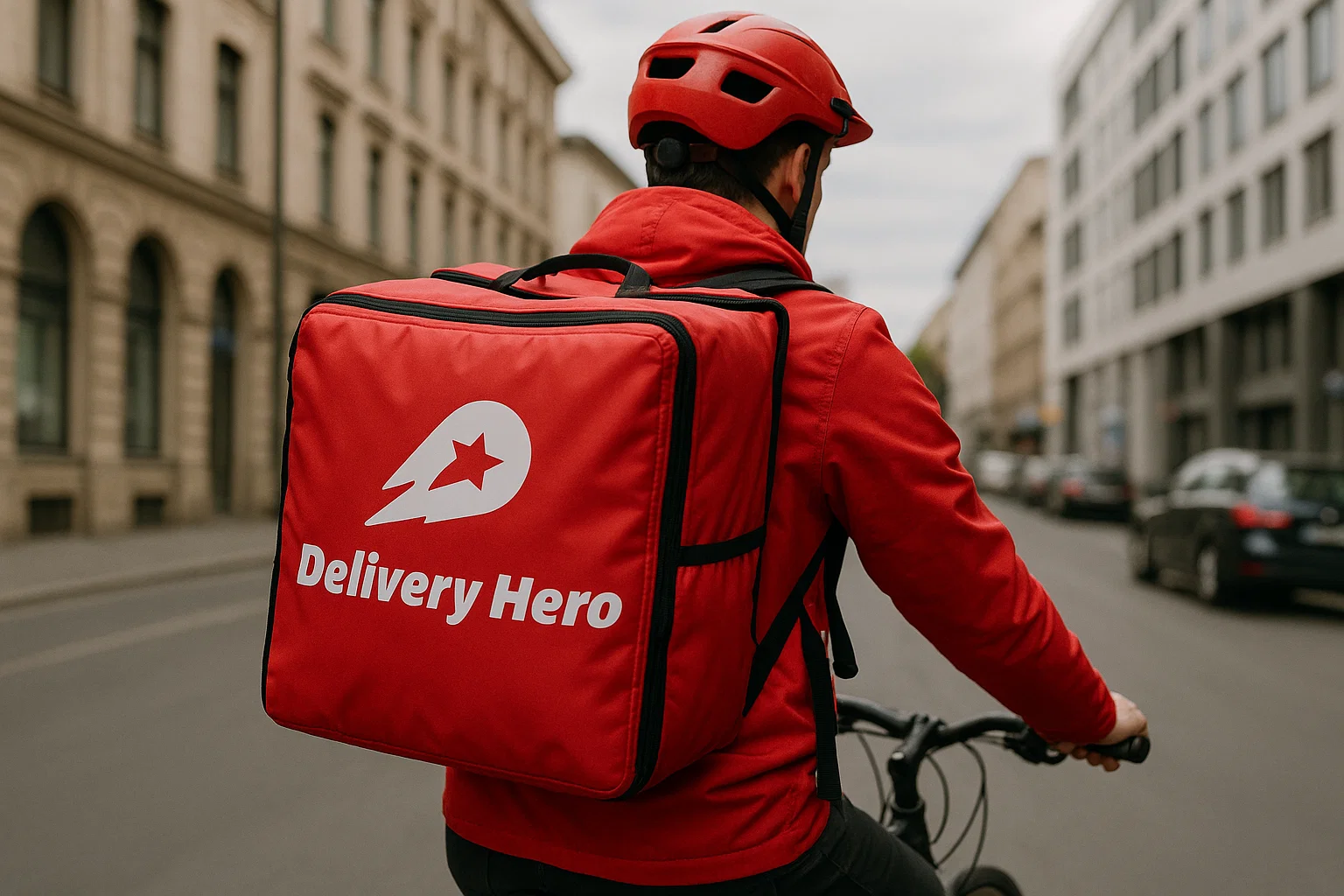Delivery Hero is one of the world’s largest food delivery networks, operating in over 70 countries through a portfolio of local brands. From quick commerce to restaurant deliveries, it has redefined convenience for millions of consumers — while building a sophisticated business model that generates billions in revenue annually.
Founded in 2011 and headquartered in Berlin, Delivery Hero isn’t just a food delivery app. It’s a logistics powerhouse, data-driven platform, and multi-brand empire rolled into one. In 2024, the company reported revenues exceeding €10 billion, driven by a mix of commissions, delivery fees, advertising, and quick commerce sales.
For startup founders and digital agencies eyeing the food delivery space, understanding how Delivery Hero makes money is more than just insightful — it’s a blueprint for success.
In this blog, we’ll explore the revenue streams behind Delivery Hero, why the model is still scalable in 2025, and how startups can launch a Delivery Hero-style platform quickly using a white-label clone from Miracuves.
How Delivery Hero Makes Money
Delivery Hero’s revenue model is multi-layered, combining traditional marketplace commissions with innovative monetization channels. Here are the major income sources:
- Commissions from Restaurants and Vendors – Delivery Hero charges partner restaurants a commission for each order placed via the app, typically ranging between 20–30%.
- Delivery and Service Fees from Customers – End users pay delivery charges, surge fees, and platform service fees on each transaction.
- Quick Commerce (q-commerce) Sales – Revenue from its own grocery and essentials delivery service (like Dmart or Foodpanda Shops), where Delivery Hero controls both inventory and fulfillment.
- Advertising and Sponsored Listings – Restaurants and FMCG brands pay for visibility via banner ads and prioritized listings in the app.
- Subscription Plans – Premium user subscriptions (e.g., free delivery or loyalty perks) offer recurring income.
- Logistics-as-a-Service – Some markets offer last-mile delivery infrastructure to non-food retailers, generating B2B logistics revenue.

Together, these channels make Delivery Hero a global revenue machine — balancing volume with diversified income across B2C and B2B verticals.
From food to groceries and beyond, Delivery Hero powers global on-demand services—explore the Delivery Hero features every startup should know.
Detailed Breakdown of Revenue Channels
Commissions from Restaurants and Vendors
Delivery Hero’s core revenue stream comes from charging restaurants a commission per order. These commissions typically range from 20% to 30%, depending on the market, order volume, and partnership tier. For restaurants, the trade-off is visibility, traffic, and access to a broader delivery infrastructure they couldn’t easily build themselves.
- Who Pays? Partner restaurants and stores
- Why It Scales? The more vendors and orders on the platform, the greater the commission revenue with virtually no marginal cost
Delivery and Service Fees from Customers
Customers pay fixed delivery fees and dynamic service charges. These may vary based on distance, demand, weather conditions, and time of day. In peak hours, surge pricing adds even more revenue. These small charges, applied to millions of orders daily, create a powerful micro-transaction engine.
- Who Pays? End customers
- Why It Scales? Revenue grows with order volume and user base, especially in high-density markets
Quick Commerce (Q-Commerce) Sales
Unlike traditional food delivery, Delivery Hero’s q-commerce vertical handles its own inventory — including groceries, snacks, drinks, and OTC products — stored in strategically placed dark stores or micro-fulfillment centers. This gives Delivery Hero full control over margins, pricing, and delivery times, often under 15–20 minutes.
- Who Pays? End customers buying everyday essentials
- Why It Scales? Higher margin per order, repeat purchases, and reduced reliance on restaurant partners
Advertising and Sponsored Listings
Restaurants and FMCG brands can pay for premium placements, banner ads, and search boost features. Sponsored listings get featured on top of search results or homepages, driving more visibility and orders. This is a high-margin revenue stream, especially in competitive food and retail categories.
- Who Pays? Restaurants, cloud kitchens, and packaged goods brands
- Why It Scales? More partners compete for visibility as the platform grows
Subscription Plans
Delivery Hero offers subscription plans in several regions (similar to DoorDash Pass or Uber One) that give users benefits like free delivery, exclusive discounts, or priority support. These monthly or annual plans improve customer loyalty while generating predictable recurring revenue.
- Who Pays? Regular users and power customers
- Why It Scales? Increases order frequency and customer lifetime value
Logistics-as-a-Service (LaaS)
Beyond food, Delivery Hero also offers last-mile delivery logistics for third-party businesses, especially in retail and e-commerce. With their established fleet and dispatch systems, they provide infrastructure for other brands to deliver faster — for a fee.
- Who Pays? External merchants, e-commerce brands, and retailers
- Why It Scales? Uses existing delivery fleet to tap into new B2B revenue without major investment
DeliveryHero turned food delivery into a global empire with smart campaigns—explore the DeliveryHero marketing strategy that fuels lasting growth.
Why This Revenue Model Works in 2025
Delivery Hero’s business model is built for today’s digital-first, convenience-driven world — and in 2025, it’s more effective than ever. Here’s why the model continues to scale globally:
Surging Demand for Quick Commerce
With urban consumers demanding 15–30 minute deliveries for everything from groceries to daily essentials, Delivery Hero’s q-commerce model has gained massive traction. By owning the inventory and delivery flow, they command better margins and brand loyalty.
Platform Effects and Network Growth
The more restaurants and users join the platform, the stronger Delivery Hero becomes. This flywheel effect — where selection drives demand and vice versa — enhances both B2C and B2B monetization strategies.
Dynamic Pricing and AI Optimization
Delivery Hero uses AI-driven pricing to optimize delivery charges, allocate fleets in real time, and suggest upsells. Smart delivery routing and predictive order clustering reduce costs and boost delivery volumes per hour.
Shift to Subscription and Loyalty
With user acquisition costs rising, loyalty programs and subscriptions offer stable, long-term revenue while increasing order frequency. Delivery Hero leverages this to improve retention and reduce churn.
Diversification Beyond Food
By expanding into groceries, alcohol, medicine, and third-party logistics, Delivery Hero is no longer just a “food delivery app” — it’s an everything-now commerce engine. This diversification shields it from seasonal demand dips and creates cross-sell opportunities.
Global Multi-Brand Portfolio
Operating through localized brands like Talabat, Foodpanda, and Baemin allows Delivery Hero to adapt its pricing and partnerships based on regional economics — a smart strategy for risk management and hyper-local revenue optimization.
From food and groceries to quick commerce, Delivery Hero simplifies on-demand needs—see how Delivery Hero works for millions daily.
Can Startups Replicate Delivery Hero’s Revenue Model?
Yes — but replicating Delivery Hero’s scale and sophistication requires more than just an app. You’ll need:
- Real-time delivery tracking
- Commission and fee management engines
- Q-commerce inventory tools
- Fleet logistics coordination
- Merchant onboarding systems
- Ad monetization dashboards
- Subscription and loyalty integrations
Building all of that from scratch could take years — and millions in development.
That’s where Miracuves steps in.
With our ready-made Delivery Hero Clone, startups can launch a high-performance delivery platform equipped with:
- Multi-restaurant ordering and commission control
- Dynamic delivery and convenience fee engines
- Quick commerce modules with dark store support
- Rider tracking and dispatch automation
- Banner ad management for paid promotions
- Subscription-based user models and loyalty programs
- Real-time analytics for merchants and admin
You can customize the design, features, and monetization strategy — and go live in weeks instead of years. Whether you’re targeting a niche city or a multi-country roll-out, Miracuves provides the flexibility and scalability to match Delivery Hero’s model with lower risk and faster ROI.
The Delivery Hero Clone by Miracuves is priced at $3,299, built for multi-service on-demand delivery platforms.
Manage food, groceries, pharmacy, and parcel delivery with real-time tracking and scalability.
Go live in just 3–6 days with 60 days of tech support.
Startups aiming to enter the on-demand delivery space can launch faster with the best Delivery Hero clone scripts in 2025, build smarter using our developer guide to creating a Delivery Hero-like app, and scale confidently by choosing our Delivery Hero clone over costly custom development.
Conclusion
Delivery Hero’s revenue model thrives on variety, scalability, and precision. From restaurant commissions and delivery fees to quick commerce and advertising, every part of the platform is engineered for monetization at scale. Its adaptability to different markets, strong logistics infrastructure, and focus on both B2C and B2B streams make it one of the most successful delivery platforms globally.
The good news? You don’t need a billion-dollar budget to build something similar.
With Miracuves’ Delivery Hero Clone, you can launch your own branded delivery platform with built-in monetization features — commission control, q-commerce, ad slots, subscriptions, and more — all ready to go from day one.
FAQs
How does Delivery Hero generate revenue?
Delivery Hero generates revenue through commissions on food and grocery orders, delivery fees, quick commerce sales, advertising, subscriptions, and third-party logistics services. Each channel is designed to scale with order volume and user engagement.
Is Delivery Hero profitable in 2025?
While Delivery Hero continues to invest heavily in expansion and q-commerce, its diversified income streams and strong unit economics in key markets have brought it closer to profitability in 2025, especially in regions with established logistics networks.
What are the main income sources for Delivery Hero?
The main income sources include vendor commissions, customer delivery charges, high-margin q-commerce sales, platform ads, and loyalty-based subscription plans. B2B logistics services are also becoming a growing revenue stream.
Can startups use the same revenue model as Delivery Hero?
Yes, startups can replicate Delivery Hero’s revenue model using a pre-built platform like Miracuves’ Delivery Hero Clone. It includes features to monetize through commissions, subscriptions, ads, and quick commerce from day one.
Does Miracuves offer a Delivery Hero clone with monetization features?
Absolutely. Miracuves offers a robust Delivery Hero Clone solution with all key monetization tools — from commission management and service fees to q-commerce modules, advertising dashboards, and loyalty programs.
Related Articles :-
- Revenue Model of Foodpanda: How the Food Delivery Giant Makes Money
- Revenue Model of HungerStation: How Saudi Arabia’s Food Delivery Leader Drives Profit
- Revenue Model of Goldbelly: How It Serves Gourmet Food with a Side of Profits
- Revenue Model of Just Eat: How the Food Delivery Giant Monetizes Every Order








